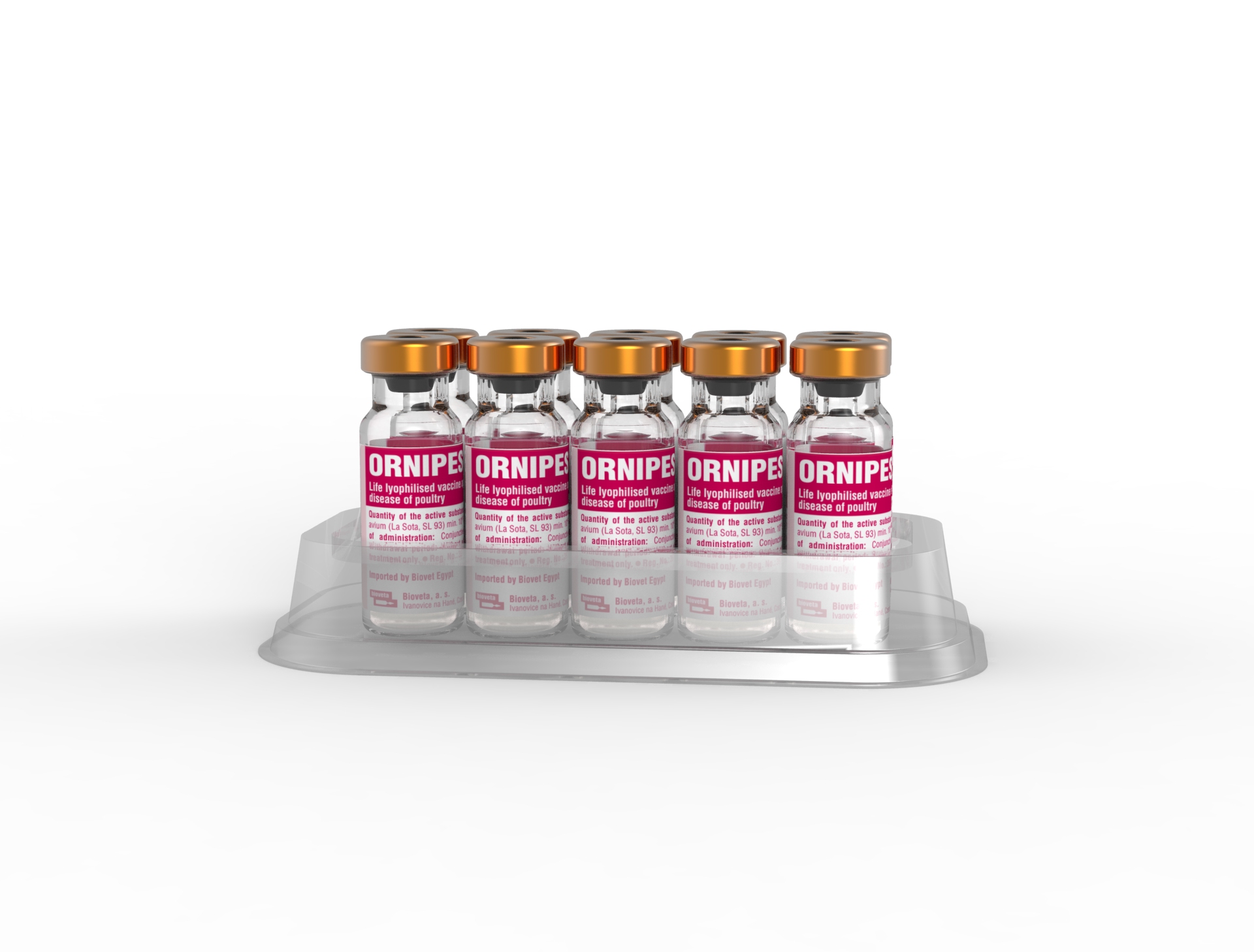
live lyophilized vaccine against Newcastle disease of poultry
STATEMENT OF THE ACTIVE SUBSTANCE(S) AND OTHER INGREDIENT(S)
One vaccine dose contains:
Active substance:
Paramyxovirus pseudopestis avium (La Sota, SL 93) min. 106.0EID50, max. 108.0EID50** EID50–50% infectious dose forchicken embryos
Excipients:
Lyophilisation medium
INDICATION(S)
Active immunization of domestic fowl from 14 days of age against Newcastle disease.
The onset of immunity in vaccinated poultry is within 14 days. Immunity
persists until the end of fattening in broilers, breeding domestic fowls should be revaccinated 4 weeks and then 2 weeks before laying. After revaccination immunity lasts for 3-5 months. It is recommended to revaccinate layers according to results of serological tests.
CONTRAINDICATIONS
It is not recommended to vaccinate sick poultry and domestic fowl until 14 days of age.
ADVERSEREACTIONS
None known
TARGET SPECIES
Domestic fowl
DOSAGE FOR EACH SPECIES, ROUTE(S) AND METHOD OF ADMINISTRATION
Individual application:
200 vaccine doses should be diluted in 10 ml of water for injection. Diluted vaccine is dripped on the conjunctival mucosa of individual birds.
Mass spray application:
The vaccine is administered diluted with water for injection, using a spray gun generating micro-droplets.
1000 vaccine doses should be diluted in 200-250 ml of water for injection.
Mass application to drinking water:
The vaccine is administered dissolved in a quantity of drinking water that can be drunk by the poultry within 1 to 2 hours after dilution of the vaccine.
For oral administration the vaccine can be diluted only in cold clean drinking water free of antiseptics and disinfectants. Increased temperature and the content of antiseptics and disinfectants in water reduce significantly the volume of the vaccine virus in a dose.
Breedingdomestic fowls should be revaccinated a month after the first vaccination and before moving to lay at the age of 14 to 16 weeks. Layers should be revaccinated at intervals of three to five months,preferably on the basis of serological tests.
ADVICE ON CORRECT ADMINISTRATION
Spray vaccination ensures better immunity than the vaccine in drinking water.Domestic fowls should be vaccinated from 14 days of age by application of a coarse spray, sprayed evenly over an appropriate number of poultry from a distance of 30-50 cm. Too fine microdroplets (aerosolmist) cause inhalation of the vaccine virus into the lower airways and, consequently, development of the respiratory disease. The administration of aerosol therapy is suitable only for revaccination of older poultry and spray mist is generated through a spray gun in the area above the poultry.
WITHDRAWAL PERIOD
Not applicable.
SPECIAL STORAGE PRECAUTIONS
Keep out of the reach and sight of children.Store in a refrigerator (2C-8C).
The vaccine should not be exposed to long-term temperatures above 8C.Shelf-life of the veterinary medicinal product as packaged for sale: 30 months.Shelf life after reconstitution: Consume immediately.
SPECIAL WARNING
Use usual aseptic measures in all procedures related to administration of the product.
The avian Newcastle disease vaccine virus strain La Sota, SL 93 reproduces and spreads in the bodies of vaccinateddomestic fowls after administration. Several days after vaccination the vaccine virus is excreted, to a limited extent, into the environment whereit can attack other susceptible animals. Safety studies have shown that the vaccine virus is safe for target animals and passaging on the target animal does not increase its virulence or produce clinical signs of the disease. Therefore, it is not necessary to take any special veterinary and animal husbandry measures in the context of vaccination.
No information is available on the safety and efficacy of this vaccine when administered concurrentlywith other veterinary medicinal products. Decision about using this vaccine before or after any other veterinary medicinal product must be based on consideration of individual cases.
Administration of the vaccine has no effect on the laying, fertilization and hatching.
Special precautions to be taken by the person administering the veterinary medicinal product to animals
Avoid exposure to the virus during vaccination and wear protective goggles and a mask during the spray application. Wash and disinfect your hands after the vaccination is finished. Wash used equipment and inactivate vaccine residues with an effective disinfectant, or by heat treatment (boiling and burning).
SPECIAL PRECAUTIONS FOR THE DISPOSAL OF UNUSED PRODUCT OR WASTE MATERIALS, IF ANY
Dispose of waste material by boiling, incineration or immersion in an appropriate disinfectant approved for this purpose by competent authorities.
OTHER INFORMATION
For animal treatment only-to be supplied onlyon veterinary prescription.
Immediate packing: 3-ml or 9-ml vial of hydrolytic glass type I, containing 200, 500, 1000, 2,500, 5000 doses of lyophilised vaccine. The vial is closed with a rubber lyophilisation stopper and an aluminium cap.
The vaccine is packaged in plastic or cardboard containers:
Individual packaging
1 x 200 doses, 1 x 500 doses, 1 x 1000 doses, 1 x 2500 doses, 1 x 5000 doses
Group packaging
10 x 200 doses, 10 x 500 doses, 10 x 1000 doses, 10 x 2500 doses, 10 x 5000 dosesAn approved Package Leaflet is enclosed in every package.
Not all pack sizes may be marketed.
Add your review for the product